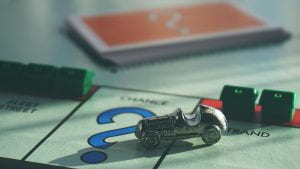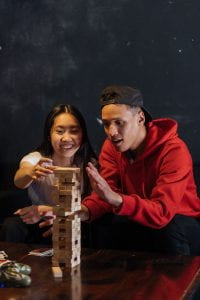By Luis Colón
Instructional Designer
luis.colon@stonybrook.edu
When we think of “games,” many of us think of activities that we normally spend our free time doing. We might think of playing sports, dusting off a board game and getting competitive with family and friends, or even the times we’ve spent in front of a new video game. These activities may seem like a “waste of time,” but instead, the concept of gamification helps us reframe playing as learning. It might be difficult to see the connection between playing games and learning because for so long the activities have served different roles in our lives. Is it possible for effective learning to occur while playing games?

Gamification, or the application of elements commonly found in games to other topics and activities, is something that most of us have actually experienced before. In fact, many well-known companies have incorporated elements of gamification into their business model. One example is Starbucks, which has an app where customers gain points and rewards that can be redeemed on purchases. Another example is Nike and its Nike Run Club app, which give users incentives such as award badges and achievements for reaching fitness goals and important milestones. These are just some ways that companies use elements commonly found in games to attract new customers and keep them as engaged and excited as possible.
If businesses can incorporate elements of gaming into their approach, could the same be done with teaching and learning? Absolutely! In fact, gamified learning is gaining popularity and results have shown that learners are more invested and likely to engage with learning content when a gamified approach is taken. For example, a 2018 systematic review of the literature study conducted by Subhash and Cudney at the Missouri University of Science and Technology found that in many cases the adaptation of a gamified framework led to an improvement in attitude, engagement, performance, and retention among learners.

A more recent 2022 study used the theory of disruptive innovation to explore student satisfaction in 18 college courses that used gamification and a social media- like platform. Participants in the study reported feeling engaged, welcomed feedback, and said they enjoyed the communication and collaboration that the platform allowed. One of the most popular examples of a gamified learning experience is the Duolingo app which is used for language learning. Users are awarded experience points after each lesson and, rewarded for streaks of consistent engagement. The competitive leaderboard displays the top score and keeps players engaging to stay at the top.
So, how can you add gamified elements to the learning experience? Miller et al. (2021) discuss multiple additions and/or adjustments that can be made to a course or course content to give it a more gamified look and feel in their book, Game Based and Adaptive Learning Strategies. Some of these include:
- Modify the Vocabulary – In some cases, much of what is already done in a course can be renamed in a way that will be more game-like. A module can be a level or world. Grades can serve as XP (experience points) or currency. An assignment sounds way more exciting when it’s called a quest.
- Provide Context – Some of the best games of all time are not only fun but are great examples of storytelling as well. Consider what the overall goal is and what you want learners to do. Will your learners be superheroes trying to thwart an evil villain or explorers on a mission to space? Whatever it is, be sure to have a strong and consistent story throughout the learning experience.
- Create Diverse Assignments – No matter how much fun a game is, eventually it can become repetitive and cause the player to lose interest. By planning and creating different types of assignments and learning experiences, you can keep learners engaged and on their toes for what might come next.
- Be Prompt and Consistent – In a game, we often know where we stand as soon as the level is over, which gives us a sense of accomplishment. We can carry that into our teaching practice by providing useful feedback, updating grades, and offering assistance as often as possible to keep learners motivated.
Taking the time to incorporate some of these tweaks to your course content can be a great way to add a new and exciting dimension to your teaching. Gamification is everywhere in our everyday lives and with a growing amount of research to support its effectiveness in the learning environment, it is clearly a strategy to keep in mind when organizing and developing dynamic and exciting learning experiences.
References
Ensmann, S., & Whiteside, A. (2022). ‘It helped to know I wasn’t alone’: Exploring student satisfaction in an online community with a gamified, social media-like instructional approach. Online Learning, 26(3). https://doi.org/10.24059/olj.v26i3.3340.
Subhash, S., & Cudney, E. A. (2018). Gamified learning in higher education: A systematic review of the literature. Computers in Human Behavior, 87, 192-206. https://doi.org/10.1016/j.chb.2018.05.028
Miller, C. L. and Batsaikhan, O. (Eds). (2021). Game-Based and Adaptive Learning Strategies. Mankato, MN: Minnesota State University, Mankato. https://mlpp.pressbooks.pub/gamebasedlearning/. Licensed under a Creative Commons Attribution-NonCommercial 4.0 International License CC BY 2021.
